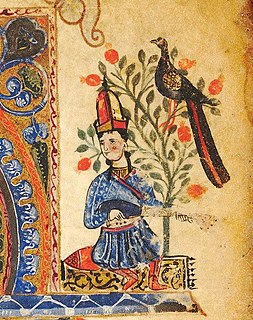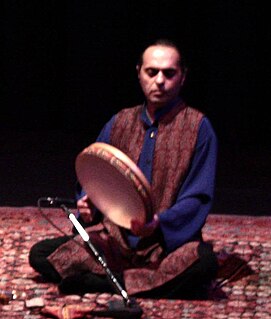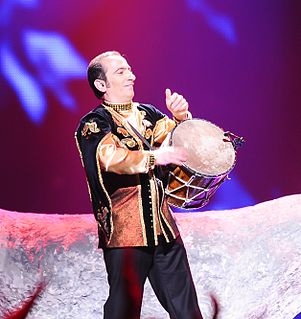 W
WThe bağlama is a stringed musical instrument.
 W
WThe davul, tapan, atabal or tabl is a large double-headed drum that is played with mallets. It has many names depending on the country and region. These drums are commonly used in the music of Middle East. These drums have both a deep bass sound and a thin treble sound due to their construction and playing style, where different heads and sticks are used to produce different sounds on the same drum.
 W
WA dayereh is a medium-sized frame drum with jingles, used to accompany both popular and classical music in Iran, Tajikistan, Afghanistan, Bukharan Jews, Azerbaijan, the Caucasus, the Balkans, and many Central Asian countries such as Tajikistan, and Uzbekistan. Frame drums are also popular in many regions of Georgia, like Kartli, Kakheti, Tusheti, Samegrelo, Racha, and Imereti. This is a single headed percussion instrument which is not only found in Northern South Asia, Central Asia, and the Middle East, but also in parts of the Russian polar regions. The simple drum is formed by attaching a skin cover onto a wooden ring with glue and cloth ties. This is similar to the Persian daira and the Turkish def. Some daira have metal pieces attached to give them a tambourine-like quality.
 W
WThe dutar is a traditional long-necked two-stringed lute found in Iran and Central Asia. Its name comes from the Persian word for "two strings", دوتار do tār, although the Herati dutar of Afghanistan has fourteen strings. When played, the strings are usually plucked by the Uyghurs of Western China and strummed and plucked by the Tajiks, Turkmen, Uzbeks. Related instruments include the Kazakh dombra. The Dutar is also an important instrument among the Kurds of Khorasan amongst whom Haj Ghorban Soleimani of Quchan was a noted virtuoso. In Kurdish one who plays the dutar is known as a bakci (bakhshi), while in Azeri the term is ashiq. Khorasan bakhshi music is recognized on the Representative List of the Intangible Cultural Heritage of Humanity.
 W
WThe ghijak (also spelled ghidjak, ghichak, gidzhak, gijak, g'ijjak,, or ghijek, is a group of related spike fiddles, used by Afghans, Uzbeks, Uyghurs, Tajiks, Turkmens, Qaraqalpaks and in the Xinjiang province of western China. Despite the similarity of the name, it is more closely related to the Persian kamancheh than the ghaychak.
 W
WThe kaval is a chromatic end-blown flute traditionally played throughout the Balkans and Anatolia. The kaval is primarily associated with mountain shepherds.
 W
WThe komuz or qomuz is an ancient fretless string instrument used in Central Asian music, related to certain other Turkic string instruments and the lute.
 W
WThe nagara or naghara is a drum used in the Middle East. There are several types of naghara, which is considered to be the lead instrument in folk ceremonies and weddings. The naghara differs in size and goes by various names such as "boyuk nagara", "cura nagara", "chiling naghara"(played with drum sticks), "Qoltuq nagara", gosha naghara (Naqareh) and "el naghara".
 W
WThe naqqāra, nagara or nagada is a Middle Eastern drum with a rounded back and a hide head, usually played in pairs. It is thus a membranophone of the kettle drum variety.
 W
WThe qanun, kanun, ganoun or kanoon is a string instrument played either solo, or more often as part of an ensemble, in much of the Middle East, North Africa, West Africa, Central Asia, and southeastern regions of Europe. The name derives from the Arabic word qanun, meaning "rule, law, norm, principle", which is borrowed from the ancient Greek word and musical instrument κανών (rule), which in Latin was called canon. Traditional and Classical musics executed on the qanun are based on Maqamat or Makamlar. Qanun trace its origins to a stringed Assyrian instrument from the Old Assyrian Empire, specifically from the nineteenth century BC in Mesopotamia. This instrument came inscribed on a box of elephant ivory found in the old Assyrian capital Nimrud, which is located about 35 km from the city of Mosul in Iraq. The instrument is a type of large zither with a thin trapezoidal soundboard that is famous for its unique melodramatic sound.
 W
WThe Qoltuq nagara(Armpit drum) is a folk drum with double head that is played on one side with the bare hands. It is used in Armenia, Turkey, Iranian Azerbaijanis, Azerbaijan Georgia and other Caucasus regions. It has different names, according to the territory in which it is played. This membranophone is different from the dhol and nagara of India.
 W
WThe zurna is a double reed wind instrument played in central Eurasia, Western Asia and parts of North Africa. It is usually accompanied by a davul in Anatolian and Assyrian folk music.